the place where Paleontology and Paleoanthropology meets Philately
Contributors to Paleontology science
Scientists and other personalities who had a significant influence on the establishment of Paleontology science, famous fossil collectors, museum founders, etc.
The personalities list:
Georgius Agricola (1494- 1555)
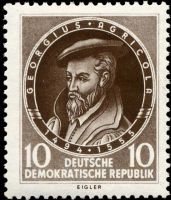
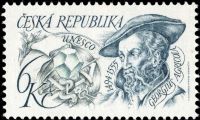 Georg Bauer, better known by the Latin version of his name Georgius Agricola, is considered the founder of geology as
a discipline.
Georg Bauer, better known by the Latin version of his name Georgius Agricola, is considered the founder of geology as
a discipline. His work paved the way for further systematic study of the Earth and of its rocks, minerals, and fossils.
In 1544, he published the De ortu et causis subterraneorum, in which he laid the first foundations of a physical geology, and criticized the theories of the ancients.
However, he maintained that a certain 'materia pinguis' or 'fatty matter,' set into fermentation by heat, gave birth to fossil organic shapes, as opposed to fossil shells having belonged to living animals.
In 1545, he followed with the De natura eorum quae effluunt e terra; in 1546 the De veteribus et novis metallis, a comprehensive account of the discovery and occurrence of minerals and also more commonly known as De Natura Fossilium; in 1548, the De animantibus subterraneis; and in the two following years a number of smaller works on the metals. [R1]
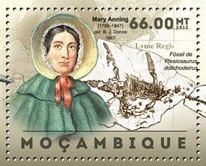
 Mary Anning (21 May 1799 – 9 March 1847) was an English fossil collector and dealer
who became known around the world for important finds she made in Jurassic marine fossil beds in the cliffs along the English Channel at
Lyme Regis, now part of what is now called the Jurassic Coast, in the county of Dorset in Southwest England.
Mary Anning (21 May 1799 – 9 March 1847) was an English fossil collector and dealer
who became known around the world for important finds she made in Jurassic marine fossil beds in the cliffs along the English Channel at
Lyme Regis, now part of what is now called the Jurassic Coast, in the county of Dorset in Southwest England. Her findings contributed to important changes in scientific thinking about prehistoric life and the history of the Earth.
Anning searched for fossils in the area's Blue Lias cliffs, particularly during the winter months when landslides exposed new fossils that had to be collected quickly before they were lost to the sea.
Her discoveries included the first Ichthyosaur skeleton correctly identified; the first two more complete Plesiosaur skeletons found; the first pterosaur skeleton located outside Germany; and important fish fossils.
Her observations played a key role in the discovery that coprolites, known as bezoar stones at the time, were fossilised faeces.
She also discovered that belemnite fossils contained fossilised ink sacs like those of modern cephalopods.
Her discoveries inspired famous geologist (and childhood friend) Henry De la Beche to paint 'Duria Antiquior - A More Ancient Dorset' in 1830.
He sold prints to raise money for Mary, who was still struggling to make ends meet.
Duria Antiquior - complete with ichthyosaur, plesiosaur and pterosaur - is the very first pictoral representation of prehistoric life based on fossil evidence.
Today the Natural History Museum in London showcases several of Mary Anning's spectacular finds, including her ichthyosaur, plesiosaur and pterosaur.
Much like they did two centuries ago, her fossils continue to captivate visitors from around the world. [R2]
Juan Bautista Ambrosetti was an Argentine archaeologist and naturalist.
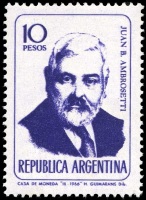
|
| Argentina 1966, MiNr.: 942, Scott: 905 |
In 1890 he published "Observations on the Oligocene fossil reptiles of the Tertiary lands of the ancient Paraná" (original name: “Observaciones sobre los reptiles fósiles oligocenos de los terrenos terciarios antiguos del Paraná” ) in the bulletin of the National Academy of Sciences of Córdoba. In this article he described some fossils from collection of Entre Ríos Museum in Paraná City, such as prehistoric lizard Propodinema from late Miocene (9.0 - 6.8 million year ago) (nowadays Propodinema is a synonym of Tupinambis). Some prehistoric crocodiles of genus Oxysdonsaurus and Proalligator.
Ambrosetti published a second article a few years later in the bulletin of the Argentinian Geographic Institute. “Contributions to the study of Oligocene fluvial tortoises in the old tertiary land in the Paraná” (original name: “Contribución al estudio de las tortugas fluviales oligocenas de los terrenos terciarios antiguos del Paraná”). In this article he described some prehistoric tortoises of Platemys genus from collection of Parana Museum. [R23]
Known Philatelic items: commemorative stamp of Argentina 1966 from "Scientists" stamps set (see above), MiNr.: 942, Scott: 905
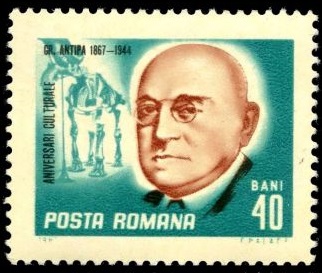 Grigores Antipa (1861-1944) was
the zoologist, ichthyologist, Hydrobiology, economist, ecologist,
oceanology, museology.
Grigores Antipa (1861-1944) was
the zoologist, ichthyologist, Hydrobiology, economist, ecologist,
oceanology, museology. He founded the Romanian school of Hydrobiology, ichthyology and oceanology, pioneer in the field of museology, the author of modern concepts in ecology, biosociologiei, biosphere.
He was director of the Museum of Natural History in Bucharest, where he had an important contribution to the organization on a phylogenetic and ecological collections.
As a token of gratitude for his work in the museum since 1933, Museum of Natural History bears his name.
Some web sites or even catalogues mentioned this stamp as stamp of first paleontologist, but it is wrong.
The missleading is caused by fossil of Dinotherium giganteum depicting on a background of the stamp.
It is there just because it is the most impressive artifact of the museum. [R3]
Karl Ernst von Baer (1792 – 1876), born in Estonia was a Baltic German scientist: naturalist, biologist, geologist, meteorologist, geographer (explorer of European Russia and Scandinavia) and a founding father of embryology.
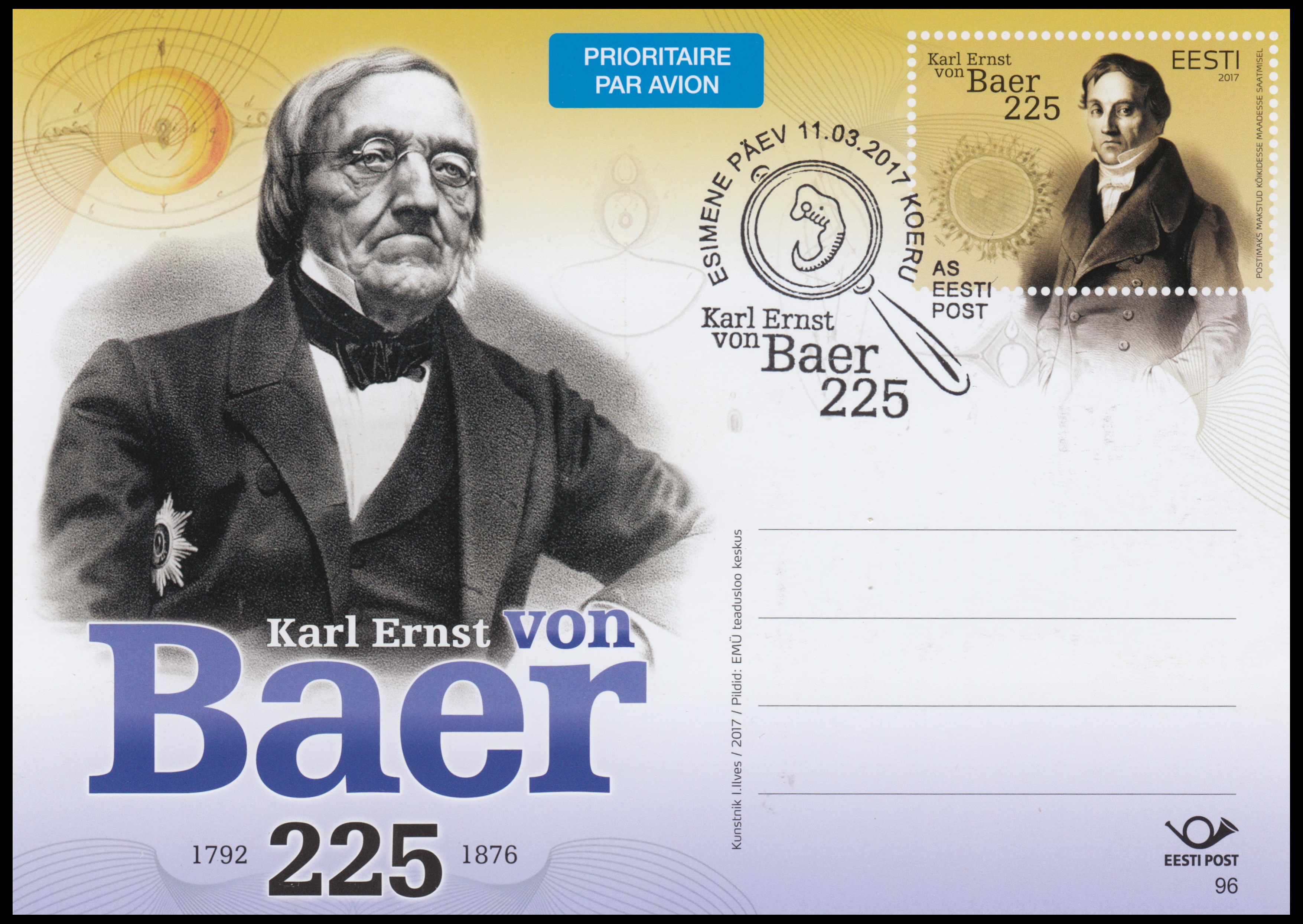
Karl Ernst von Baer on postal stationery of Estonia 2017 |
When the first fully preserved skeleton of a woolly mammoth brought to St. Petersburg Academy of Sciences by Michael Adams in 1806.
The Adams mammoth is the first woolly mammoth skeleton with skin and flesh still attached to be recovered by scientists.
The mostly complete skeleton and flesh were discovered in 1799 in northeastern Siberia by Ossip Shumachov,
an Evenki hunter and subsequently recovered in 1806 when Russian botanist Mikhail Adams journeyed to the location and collected the remains.
It was Baer’s guess that mammoth corpses could survive for several thousands of years but only in permafrost.
Adams’s report on the conditions of the site where the mammoth was found was contradictory. Baer was unable to understand how the mammoth came to be there. He thought that there were three possibilities: it was located on an iceberg, it was in ice heaped up on the shore of a river, or it had melted from an ice-wall covered with soil.
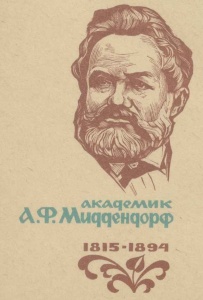
Alexander Theodor von Middendorff on postal stationery of USSR 1965 |
To clarify it, he organized an expedition to Siberia, headed by Alexander Theodor von Middendorff that took place between 1842 and 1845. One of the most important questions to be answered by Middendorff’s expedition, according to Baer, was to fix as exactly as possible the physico-geographic and geologic conditions at the site at which Adams’ mammoth had been found, Cape Bykovski in Siberia.
Unfortunately, Middendorff was unable to find any new information about Adam's Mammoth, as to much time had passed since it was found in 1799. However, he discovered and described remnants of another mammoth on the Taymyr peninsula (at Nizhnaya-Taymyr River).
At the end of the 1850s, he began to analyse the material he had collected. He compiled an historical review of all similar finds in Siberia concluding that, in the past, mammoths had lived in the central and southern regions of Siberia, in climatic conditions quite similar to those of his time.
In 1866 Baer publish an article "Neue Auffindung eines vollständiges Mammuts, mit der Haut und den Weichtheilen, im Eisboden Sibiriens, in den Nähe der Bucht des Tas" (New discovery of a complete mammoth, with its skin and soft parts, in the ice floor of Siberia, near the Bay of the Tas) about the Mammoth, discovered by another Baltic German scientist Carl Friedrich Schmidt.
Carl Friedrich Schmidt, sometimes called just Friedrich Schmidt (1832-1908) was a geologist and botanist
in the Russian Empire and also known as the founder of Estonian geology, who described the stratigraphy and fauna of
Lower Paleozoic rocks in Estonia and neighboring areas.
In 1859-1866 Schmidt participated in several expeditions in Siberia.
In 1866 he guided an expedition of the Russian Science Academy to Siberia to describe and collect Mammoth remains, discovered at Enisej river.
In 1869 he described his discovery of the Mammoth in the article "Mittheilungen über die wissenschaftlichen Resultate der Expedition zur
Aufsuchung eines angekündigten Mammuthcadavers" (Report about the scientific results of the expedition to Search for an announced mammoth cadaver)
Known Philatelic items:
- postal stationery "150th anniversary of Estonian Naturalist's Society" of Estonia from 2003.
- postal stationery "225th anniversary of Karl Ernst von Baer" of Estonia from 2017.
- commemorative postmark "200th anniversary of Karl Ernst von Baer" of Estonia from 1992.
- postal stationery "225th anniversary of Karl Ernst von Baer, co-founder of the Russian Geographical Society" of Russia from 2017.
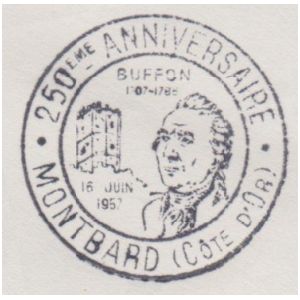
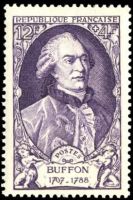 Georges-Louis Leclerc, Comte de Buffon (1707-1788)
He envisioned the nature of science and understood the roles of paleontology, zoological geography, and animal psychology.
Georges-Louis Leclerc, Comte de Buffon (1707-1788)
He envisioned the nature of science and understood the roles of paleontology, zoological geography, and animal psychology. He realized both the necessity of transformism and its difficulties.
Although his cosmogony was inadequate and his theory of animal reproduction was weak, and although he did not understand the problem of classification, he did establish the intellectual framework within which most naturalists up to Darwin worked.
Buffon is considered the founder of evolutionary theory. He was the first who mentioned that living species changed through time and who found some similarities between humans and apps, rhen suggested they might have a common ancestor.
George Buffon set forth his general views on species classification in the first volume of his "Histoire Naturelle".
Buffon objected to the so-called "artificial" classifications of Andrea Cesalpino and Carolus Linnaeus, stating that in nature the chain of life has small gradations from one type to another and that the discontinuous categories are all artificially constructed by mankind. [R4]
Zdenek Burian (1905-1981) was a Czech painter and book illustrator whose work played a central role in the development of palaeontological reconstructions during a remarkable career spanning five decades.
Originally recognised only in his native Czechoslovakia, Burian's fame later spread to an international audience, and a number of artists later attempted to emulate his style.
He is regarded by many as the most influential palaeo-artist of the modern era.
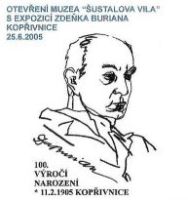 Burian was an extremely prolific artist whose works are estimated to number between 15,000 and 20,000 paintings and drawings (pen and pencil).
He illustrated over 500 books (including natural history subjects and numerous classic novels such as Robinson Crusoe, Tarzan, Plutonia)
and some 600 book covers, but it is within the fields of palaeontology and palaeoanthropology that Burian's influence has been most notable.
Burian was an extremely prolific artist whose works are estimated to number between 15,000 and 20,000 paintings and drawings (pen and pencil).
He illustrated over 500 books (including natural history subjects and numerous classic novels such as Robinson Crusoe, Tarzan, Plutonia)
and some 600 book covers, but it is within the fields of palaeontology and palaeoanthropology that Burian's influence has been most notable. Since the late 1950s and early 1960s when Burian's work became known in the west through a series of large-format books released by the Artia publishing house, numerous scholarly and popular books on prehistoric life have featured his work, either as originals or as art based closely on them.
Burian worked in initial cooperation with university palaeontologist Josef Augusta from 1938/39 (during World War II all universities in Czechoslovakia were closed due to the German occupation) and subsequently (following Augusta's death in 1968) with Zdenek pinar, painting accurate and magnificent reconstructions representing all forms of prehistoric life from many parts of the globe, from the earliest invertebrates to a vast array of fish, amphibians, reptiles, mammals and birds, as well as panoramic vistas of the landscapes in which they lived.
Close to 500 prehistoric images were painted by him between the early 1930s and the late 1970s.
Whilst some of Burian's earliest palaeo works depicting North American species were inspired by the pioneering American palaeo-artist Charles R. Knight (see for example, his first renditions of Stegosaurus and Brontotherium), partly because Burian lacked access to skeletal material for such reconstructions, Burian's work was less stylised and more convincing with respect to both the subjects and their landscapes, and soon became highly regarded amongst palaeontologists, especially in Europe.
Previous palaeo-artists had often produced speculative works reflecting 19th century views of large dinosaurs as lethargic reptiles akin to giant lizards with sprawling limbs, but Burian convincingly painted them as active animals with parasagittal (mammal or bird-like) limb-movement and musculature. [R5]
Charles Darwin (1809 -1882 ) was born in Shrewsbury, Shropshire in 12 February 1809, to a wealthy and well-connected family.
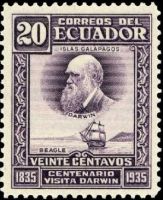
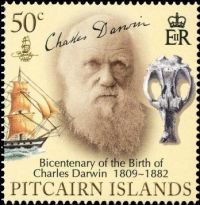 He had initially planned to study medicine at Edinburgh University but later switched to Divinity
at Cambridge encouraged a passion for natural science.
His five-year voyage on HMS Beagle established him as an eminent geologist whose observations and theories supported Charles Lyell's uniformitarian
ideas, and publication of his journal of the voyage made him famous as a popular author.
He had initially planned to study medicine at Edinburgh University but later switched to Divinity
at Cambridge encouraged a passion for natural science.
His five-year voyage on HMS Beagle established him as an eminent geologist whose observations and theories supported Charles Lyell's uniformitarian
ideas, and publication of his journal of the voyage made him famous as a popular author. Puzzled by the geographical distribution of wildlife and fossils he collected on the voyage, Darwin investigated the transmutation of species and conceived his theory of natural selection in 1838.
Although he discussed his ideas with several naturalists, he needed time for extensive research and his geological work had priority. He was writing up his theory in 1858 when Alfred Russel Wallace sent him an essay which described the same idea, prompting immediate joint publication of both of their theories.
His 1859 book On the Origin of Species established evolutionary descent with modification as the dominant scientific explanation of diversification in nature.
He examined human evolution and sexual selection in The Descent of Man, and Selection in Relation to Sex, followed by The Expression of the Emotions in Man and Animals.
His research on plants was published in a series of books, and in his final book, he examined earthworms and their effect on soil.
The fact that evolution occurs became accepted by the scientific community and much of the general public in his lifetime, while his theory of natural selection came to be widely seen as the primary explanation of the process of evolution in the 1930s, and now forms the basis of modern evolutionary theory.
In modified form, Darwin's scientific discovery is the unifying theory of the life sciences, providing logical explanation for the diversity of life.
In recognition of Darwin's pre-eminence, he was one of only five 19th century UK non-royal personages to be honoured by a state funeral, and was buried in Westminster Abbey, close to John Herschel and Isaac Newton.
Darwin's work had far-reaching impacts on the development of Paleontology, Antropology and many other Biology and Psyology related scients. [R6]

Ignacy Domeyko (31 July 1802 – 23 January 1889), was a Polish geologist, born in Miadzviedka village of Belarus, mineralogist and educator, who spent most of his life, and died, in his adopted country, Chile.
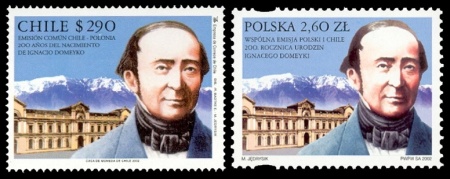 |
| Chile and Poland joint issue - 200th anniversary of Ignacy Domeyko |
He occasionally sent these fossils to French Naturalists for study.
These fossils were mainly studied by Alcide Charles Victor Marie Dessalines d’Orbigny who named some of these fossils after their discoverer.
For example, d”Orbigny named fossil species Nautilus domeykus and Ammonites domeykanus among others. These fossils are either on exhibit or archived at the Museum of Natural History in Paris together with d’Orbigny’s notes. [R26]
Known Philatelic items:
- Belarus 2002, imprinted stamp on the "postal stationery 200th anniversary of Ignacy Domeyko".
- Chile 1954, "150th anniversary of Ignacy Domeyko", MiNr.: 491-492 Scott: 282-283.
- Chile 2002, "200th anniversary of Ignacy Domeyko", joint issue with Poland, MiNr.: 2064 Scott: 1389, (see above).
- Lithuania 2002, postal stationery, "200th anniversary of Ignacy Domeyko". Domeyko's name wriiten in Lithuanian: Ignas Domeika.
- Poland 1973, a stamp with the face value of 8zl from "Polish Scientists and Explorers" set, MiNr.: 2288 Scott: 2009.
- Poland 2002, "200th anniversary of Ignacy Domeyko", joint issue with Chile, MiNr.: 3982 Scott: 3645, (see above).
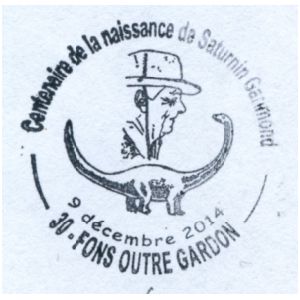 Saturnin Garimond (1914-1987), self-taught naturalist of great competence and
collaborator of of the Laboratory of Paleontology of the Institute of Evolution Sciences of Montpellier.
Saturnin Garimond (1914-1987), self-taught naturalist of great competence and
collaborator of of the Laboratory of Paleontology of the Institute of Evolution Sciences of Montpellier. 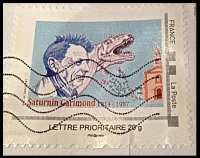
Already in age of 16, he discovered several prehistoric stations in small region of Malgoires around Fons.
In 1932 he found in the Eocene the mammalian levels reported in 19th century, and discovered on the edge of the Urgonian a higher Cretaceous utcrop not mentioned on the map, where he collects bone fragments in which he recognizes remains of Dinosaurs.
For years, he spends many days in the field with the researchers from the laboratory and actively participate in excavations in the Eocene at Fons, Euzet and Robiac. [R7]
Thomas Henrey Huxley (1825-1895) was a big defender of Charles Darwin's theory of evolution.
He received the nickname "Darwin's bulldog."
After reading Darwin's Origin of Species, Huxley reaction was: "How stupid of me not to have thought of that."
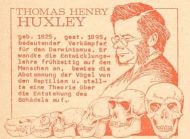 Was a self-educated intellectual giant of the 19th century, a
pioneering genius whose influence was felt throughout the science,
education, and politics of Victorian England.
Was a self-educated intellectual giant of the 19th century, a
pioneering genius whose influence was felt throughout the science,
education, and politics of Victorian England. His brilliant career ranged from surgeon's apprentice to England's Privy Council, service on 10 royal commissions, and president of the Royal Society from 1881 to 1885.
His many awards included the Royal, Copley, and Darwin medals. A man of astonishing energy and prodigious talent, Huxley had a sharp wit and a brilliant, questioning mind (traits no doubt passed on to his grandsons, including novelist Aldous Huxley). He invented the term "agnostic" to describe his own religious view, and the term's widespread, immediate acceptance freed intellectual discourse from the belief-versus-disbelief straightjacket, in and out of theistic contexts.
And yet while he was never one to sacrifice principle for propriety, he vigorously defended his ideas but always treated his opponents with respect and sometimes-astonishing courtesy.
Always a popularizer of science, he at once subscribed to Charles Darwin's theories and proved to be their most indefatigable advocate.
The role earned him the title "Darwin's bulldog", and he is best remembered today for his prominent role in defending evolution against attacks from scientists, theists, and philosophers somewhat ironic, for Huxley's biological writings show less explicit support for natural selection than for evolution itself. [R8]
Thomas Jefferson (1743-1826) USA, was third President of the United States, as universally recognized as a man of science.
He was recognized as a pioneer in ethnology, geography, anthropology and our subject paleontology.
Because of his wide range of knowledge, Jefferson was ahead of his time in several lines of inquiry and advanced of contemporary scientists.
Even so, Jefferson never failed to acknowledge that in science he was "an amateur.
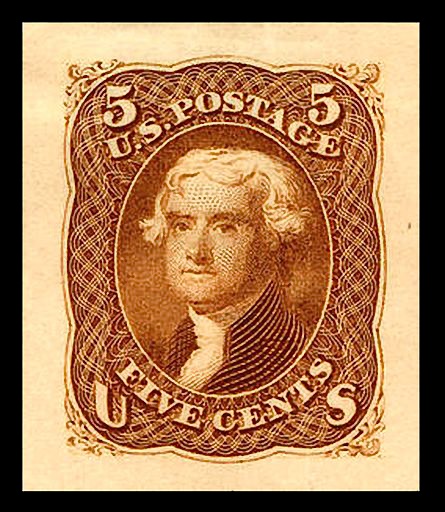
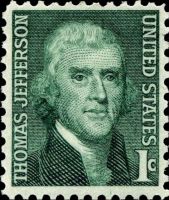 "One of the first glimpses of Jefferson's interest in paleontology can be found in his Notes on the State of Virginia.
"One of the first glimpses of Jefferson's interest in paleontology can be found in his Notes on the State of Virginia. It is his most impressive scientific achievement, in which he recorded his observations of flora, fauna, mountains, rivers, climate, population, laws, politics, customs and fossils of his native state.
In Notes Jefferson, also, refuted the contentions of Count de Buffon that the animals common to both old world and new are smaller in the new.
One of the reasons Jefferson wrote and published Notes was to refute a claim by the eminent naturalist, the Comte de Buffon, that human and animal life in America was degenerative and therefore inferior to the life forms in Europe.
Buffon believed, Jefferson wrote in his Notes, "that nature is less active, less energetic on one side of the globe than she is on the other."
Jefferson added with more than a hint of sarcasm, "as if both sides were not warmed by the same genial sun," and launched into a lengthy refutation of Buffon's hypothesis with convincing evidence that animals are actually larger in America than in Europe.
The mastodon, or mammoth,was his clincher; Europe had produced no animal to match this behemoth ... his shipment of mastodon fossils to Paris, therefore, was not entirely Enlightenment altruism; it was also a final salvo in a scientific war.
Buffon's suggestion that infant America was nature's retardate drove him to collect the ancient bones of the mammoth ...
When he received his fossils, he catalogued them carefully and precisely, as was his habit, sending them off to Philadelphia for admiration, and to Paris for edification.
He kept a few choice specimens, however, for his Monticello museum--trophies of a sort in commemoration of his private victory in the battle of New World versus Old. (McLaughlin, 1988) he entry room at Monticello had been turned by Jefferson into a Natural History Museum which showed his great interest in fossils.
Perhaps Jefferson's greatest contribution to paleontology is that while President he helped to make it a respectable pursuit and was largely responsible through the American Philosophical Society for bringing together the materials necessary for its advancement.
As the first citizen of the young nation, Jefferson's passion brought prestige and respectability to the young science. [R9]
Shen Kuo (1031-1095).
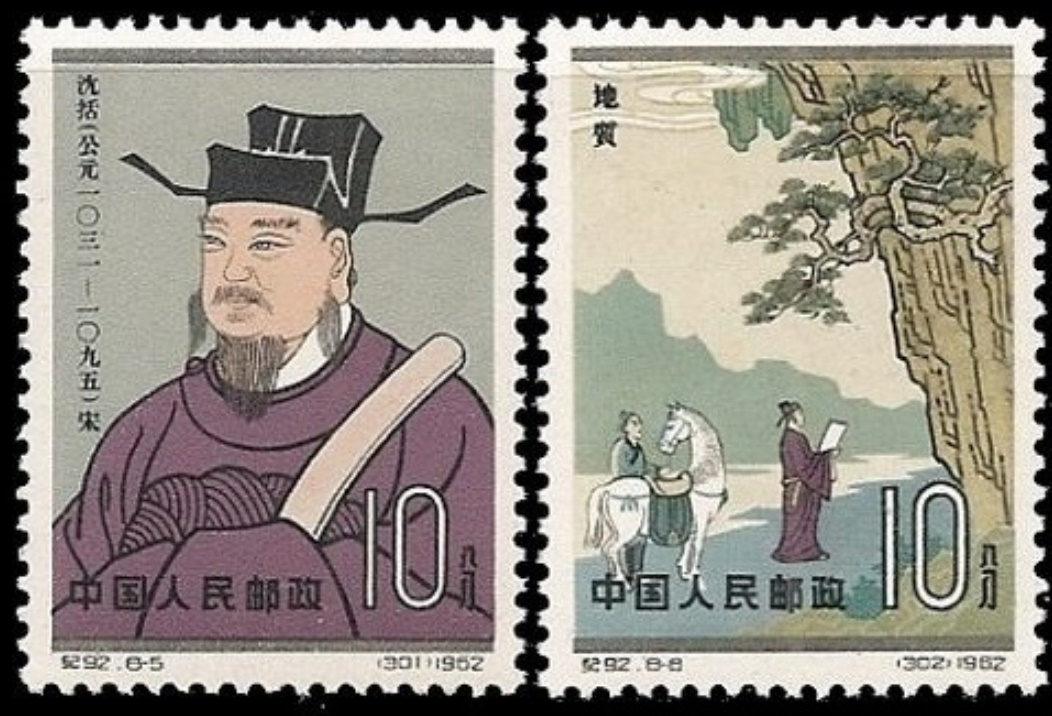
|
| Shen Kuo on stamps of China 1962, MiNr.: 671-672 Scott: 2059-2060 |
He also proposed a hypothesis of gradual climate change, after observing ancient petrified bamboo that were preserved underground in a dry northern habitat that would not support bamboo growth during his time. [R27]
Known Philatelic items:
- two stamps from "Scientists of Ancient China" of Chona 1962, MiNr.: 671-672 Scott: 2059-2060.
Jean Baptiste Lamarck (1744 - 1829), France Jean-Baptiste Pierre Antoine de Monet, Chevalier de la Marck (1 August 1744, Bazentin, Somme - 18 December 1829), often just known as "Lamarck", was a French soldier, naturalist, academic and an early proponent of the idea that evolution occurred and proceeded in accordance with natural laws.
In the modern era, Lamarck is primarily remembered for a theory of inheritance of acquired characteristics, called soft inheritance or Lamarckism.
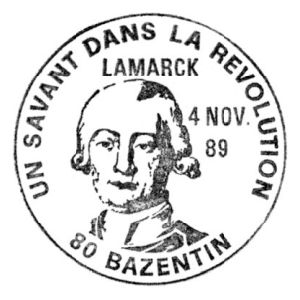
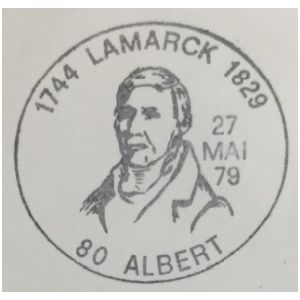 However, his idea of soft inheritance was, perhaps, a reflection of the folk wisdom of the time, accepted by many
natural historians.
However, his idea of soft inheritance was, perhaps, a reflection of the folk wisdom of the time, accepted by many
natural historians. Lamarck's contribution to evolutionary theory consisted of the first truly cohesive theory of evolution, in which an alchemical complexifying force drove organisms up a ladder of complexity, and a second environmental force adapted them to local environments through use and disuse of characteristics, differentiating them from other organisms.
Lamarckism (or Lamarckian inheritance) is the idea that an organism can pass on characteristics that it acquired during its lifetime to its offspring (also known as heritability of acquired characteristics or soft inheritance).
It is named after the French biologist Jean-Baptiste Lamarck (1744-1829), who incorporated the action of soft inheritance into his evolutionary theories. He is often incorrectly cited as the founder of soft inheritance, which proposes that individual efforts during the lifetime of the organisms were the main mechanism driving species to adaptation, as they supposedly would acquire adaptive changes and pass them on to offspring.
After publication of Charles Darwin's theory of natural selection, the importance of individual efforts in the generation of adaptation was considerably diminished.
Later, Mendelian genetics supplanted the notion of inheritance of acquired traits, eventually leading to the development of the modern evolutionary synthesis, and the general abandonment of the Lamarckian theory of evolution in biology.
Despite this abandonment, interest in Lamarckism has recently increased, as several studies in the field of epigenetics have highlighted the possible inheritance of behavioral traits acquired by the previous generation.
In a wider context, soft inheritance is of use when examining the evolution of cultures and ideas, and is related to the theory of memetics. [R10]
Carl Anton Larsen (1860 – 1924) was a Norwegian-born whaler, Antarctic explorer, and the pioneer of Antarctic whaling.
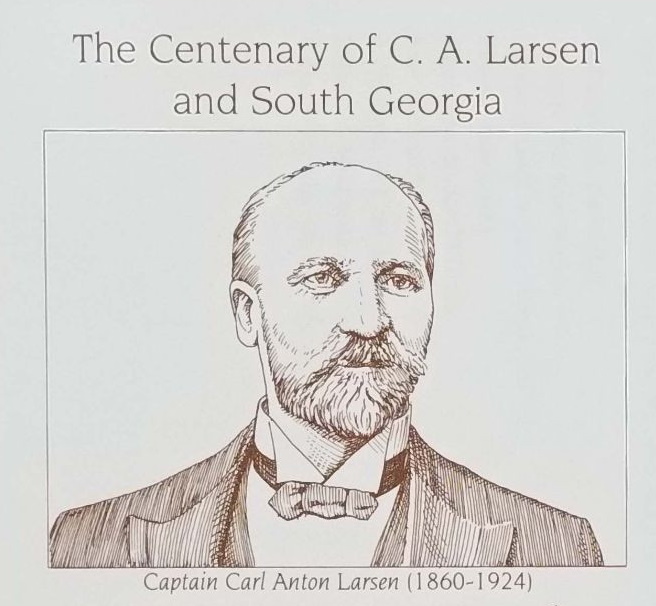
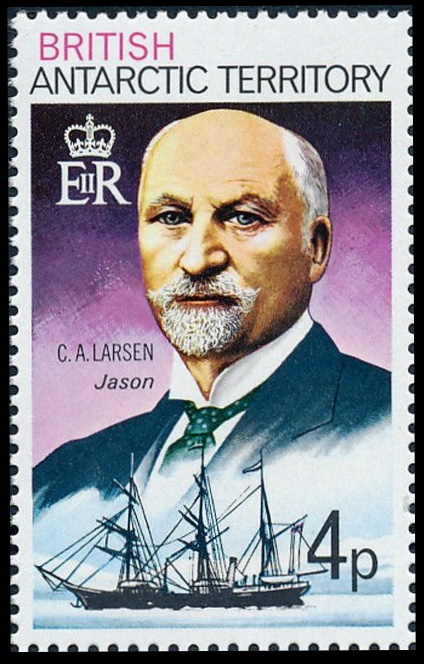 He was captain of the Jason on the Norwegian Whaling Exploration, 1892-1893, making a solitary
voyage to Antarctic waters from Sandefjord in search of opportunities for whaling.
He was captain of the Jason on the Norwegian Whaling Exploration, 1892-1893, making a solitary
voyage to Antarctic waters from Sandefjord in search of opportunities for whaling. Landing on Seymour Island, he collected specimens of sedimentary rocks that included fossils of shells and petrified wood, the first recovered from continental Antarctica for which he received the Back Grant from the Royal Geographical Society.
A decade later, in 1902, Swedish geologist Otto Nordenskjöld discovered Jurassic plant fossils, also on Seymour Island. He became one of the first to suggest that Antarctica must have experienced a much warmer climate in the past, covered by forests of ferns and tropical plants.
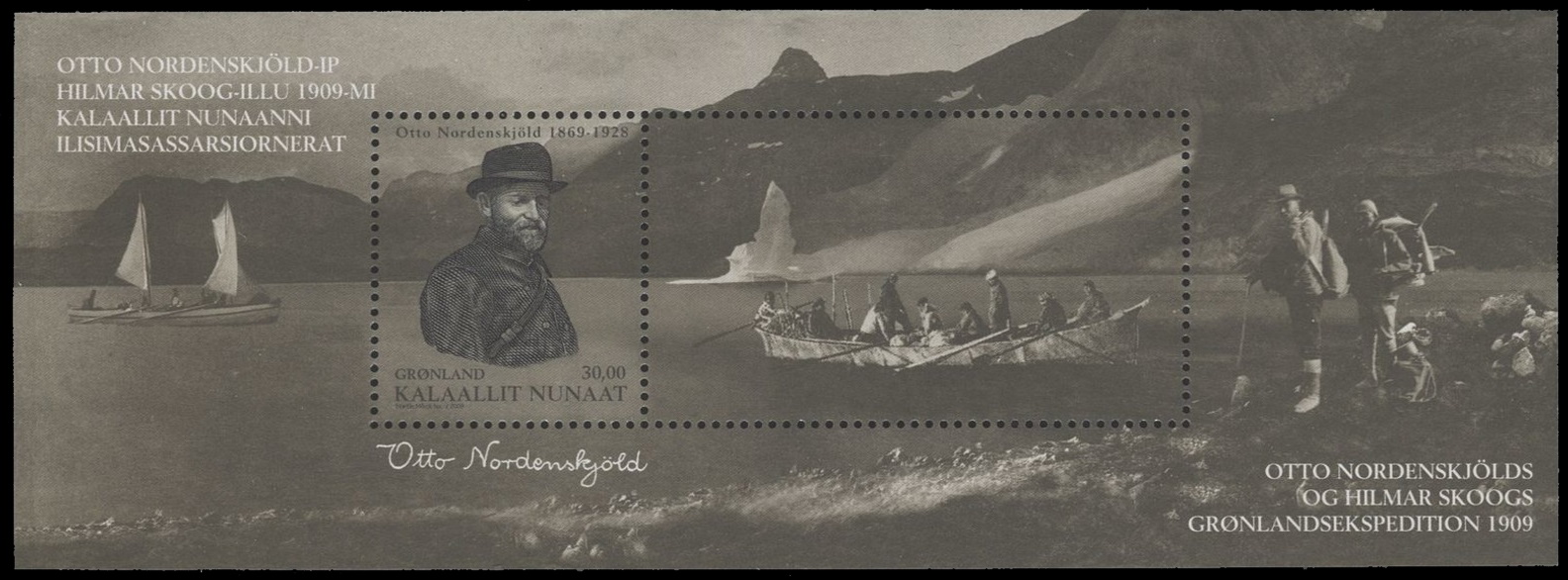
A year later, in 1903, there was another find of plant fossils, this time on the other side of the continent, during Scott’s first visit to Antarctica, the Discovery expedition.
It was the geologist Hartley Ferrar who discovered fossilized plant remains in the upper Taylor Valley, one of the famous dry valleys west of McMurdo Sound. [R29]
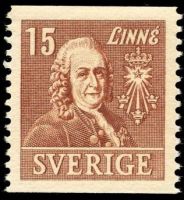
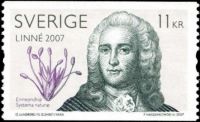 Carl Linne/Carl Linnaeus (1707 - 1778), was a Swedish
botanist, physician, and zoologist, who laid the foundations for the modern scheme of
binomial nomenclature uses in all biology related since, including paleontology.
Carl Linne/Carl Linnaeus (1707 - 1778), was a Swedish
botanist, physician, and zoologist, who laid the foundations for the modern scheme of
binomial nomenclature uses in all biology related since, including paleontology. He is known as the father of modern taxonomy and is also considered one of the fathers of modern ecology. [R11]
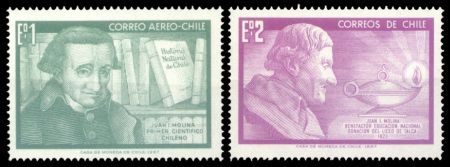
|
| Juan Ignacio Molina on stamps of Chile 1968 MiNr.: 683-684, Scott: 369-370 |
Juan Ignacio Molina (June 24, 1740 – September 12, 1829) was a Spanish later Chilean Jesuit priest, naturalist, historian, botanist, ornithologist and geographer.
As early as 1787 Molina mentioned the possibility of South America being populated from south Asia through the "infinite island chains" of the Pacific while North America could have been populated from Siberia.
He also wrote several books about Natural History of Chile. [R26]
Known Philatelic items:
- Chile 1968, "Juan Ignacio Molina", MiNr.: 683 Scott: 369.
Francisco Pascasio Moreno (May 31, 1852 – November 22, 1919) was a prominent explorer and academic in Argentina and famous collector of fossils of Argentina.
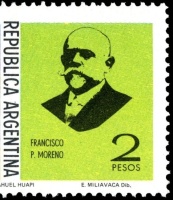
|
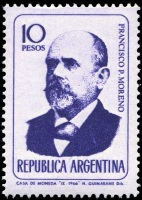
|
| Argentina 1975, MiNr.: 1219, Scott: 1068. | Argentina 1966, MiNr.: 944, Scott: 807. |
The museum was opened in house of his parents. Nowadays, many fossils of Moreno Museum can be seen in "the Museum of La Plata".
In 1880, Moreno went to France, where he spoke at a meeting of the Anthropology Society of Paris, discussing two prehistoric skulls he had unearthed in Río Negro territory.
He believed one was from the Quaternary period, and the other had ritual deformation in a manner similar to the skulls of the Aymara people of the Andes and Altiplano.
In 1888, he founded the La Plata Museum of Natural History (building of the museum can be seen on many Argentine stamps), the most important of its kind in South America, that houses 3 million fossils and relics. [R24]
Known Philatelic items: commemorative stamps of Argentina
- 1966: in "Scientists" stamps set (see on the right), MiNr. 944
- 1975: in "Pioneers of Antarctica" stamps set (see on the right), MiNr. 1219
- 2001: "150 years since birth of Dr. Francisco P. Moreno", MiNr. 2720
Francisco Javier Muniz (21 December 1795 – 8 April 1871) was an Argentine colonel, legislator, medical doctor, fossil collector and amateur paleontologist.
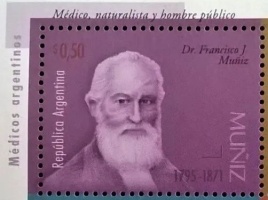
|
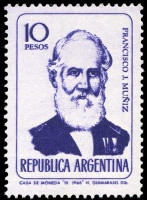
|
| Argentina 1996, MiNr.: 2297, Scott: 1922a | Argentina 1966, MiNr.: 945, Scot: 808 |
He developed a collection that he intended to be used to create a natural history museum.
He donated his artifacts (some sources say he was forced to donate them) to Juan Manuel de Rosas, who was a politician, army officer and who ruled Buenos Aires Province and briefly the Argentine Confederation at this time.
Muniz stayed in contact with Charles Darwin, with whom he exchanged some letters and articles.
It was Darwin who convinced Muniz in 1845, to send fossil of a sabertooth cat which Muniz described and named as Muni-felus bonaerensis, in Gaceta Mercantil (local newspaper) to Natural History Museum for investigation.
Experts of the museum ascribed the fossil to Smilodon bonaerensis species. [R25]
Known Philatelic items of Francisco Muniz: commemorative Argentinian stamps
- 1966: in "Scientists" stamps set (see on the right), MiNr. 945
- 1996: in "Mediciners" stamps set (see on the right), MiNr. 2297
Charles Wilson Peale (1741-1827) USA was an American painter, soldier and naturalist. He is best remembered for his portrait paintings of leading figures of the American Revolution, as well as establishing one of the first museums Peale had a great interest in natural history, and organized the first U.S. scientific expedition in 1801.
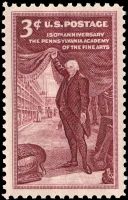 These two major interests combined in his founding of what became the Philadelphia Museum,
and was later renamed the Peale Museum.
These two major interests combined in his founding of what became the Philadelphia Museum,
and was later renamed the Peale Museum. This museum is considered the first. It housed a diverse collection of botanical, biological, and archaeological specimens. Most notably, the museum contained a large variety of birds which Peale himself acquired, and it was the first to display North American mastodon bones (which in Peale's time were referred to as mammoth bones; these common names were amended by Georges Cuvier in 1800, and his proposed usage is that employed today) display of the "mammoth" bones entered Peale into a long standing debate between Thomas Jefferson and Comte de Buffon.
Buffon argued that Europe was superior to the Americas biologically, which was illustrated through the size of animals found there.
Jefferson referenced the existence of these "mammoths" (which he believed still roamed northern regions of the continent) as evidence for a greater biodiversity in America.
Peale's display of these bones drew attention from Europe, as did his method of re-assembling large skeletal specimens in three dimension.
The museum was among the first to adopt Linnaean taxonomy.
This system drew a stark contrast between Peale's museum and his competitors who presented their artifacts as mysterious oddities of the natural world.
The museum underwent several moves during its existence. At various times it was located in several prominent buildings including Independence Hall and the original home of the American Philosophical Society.
The museum would eventually fail, in large part because Peale was unsuccessful at obtaining government funding.
After his death, the museum was sold to, and split up by, showmen P. T. Barnum and Moses Kimball. [R12]
Bernard Palissy (1510–1589) was a French Huguenot potter, hydraulics engineer and craftsman, famous for having struggled for sixteen years to imitate Chinese porcelain.
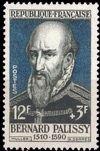 In the 19th century, Palissy's pottery became the inspiration for Mintons Ltd's Victorian
majolica, which was exhibited at the Great Exhibition of 1851 under the name "Palissy ware".
In the 19th century, Palissy's pottery became the inspiration for Mintons Ltd's Victorian
majolica, which was exhibited at the Great Exhibition of 1851 under the name "Palissy ware". Palissy is known for his contributions to the natural sciences, and is famous for discovering principles of geology, hydrology and fossil formation.
He was one of the first Europeans to enunciate the correct theory of the origin of fossils.
Palissy correctly maintained that fossils were the remains of once living organisms, and contested the prevailing view that they had been produced by the biblical flood, or by astrological influence.
He argued that minerals, dissolving into water to form "congelative water," would precipitate and thereby petrify once living organisms in order to create fossils. [R13]
Emil Racovita (1868-1947) was a Romanian biologist, zoologist, speleologist and explorer of Antarctica.
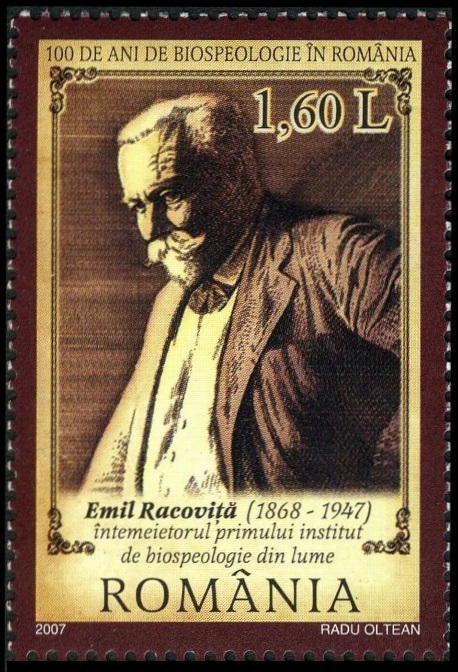 Together with Grigore Antipa, he was one of the most noted promoters of natural
sciences in Romania.
Together with Grigore Antipa, he was one of the most noted promoters of natural
sciences in Romania. Racovita was the first Romanian to have gone on a scientific research expedition to the Antarctic, more than 100 years ago, as well as an influential professor, scholar and researcher.
He found and described several fossils in caves he was observing, for example Ursilor Cave.
The cave was discovered in 1975. The name of the cave originates from the numerous cave-bear fossils discovered here, being an appropriate shelter for animals for more than 15,000 years.
They believe that the cave entrance was blocked by a fallen rock so that more than 140 bears attacked each other because of hunger.
In September 1975, a group of amateur speleologists from "Speodava" Club explored the cave for the first time and 5 years later it was opened for tourists. [R14]
Antonio Raimondi (1826-1890), was born in Milan, Italy in 1824 and was already as child very interested in natural science.
In 1850 he left Italy to escape the independence war in his country and came to Peru for researches, scientific investigations and other observations; the decision for Peru was very emotional but as well deliberate.
 He was fascinated by the at this time absolutely unexplored country of the Incas.
He was fascinated by the at this time absolutely unexplored country of the Incas. Antonio Raimondi traveled more than 19 years in countless trips through Peru and explored the country and the people under different aspects of science.
He investigated as well the impact of the Spanish presence on the Peruvians and their culture.
The already during his lifetime well respected scientist gathered animals, plants, insects, mineral, stones, fossils, drew maps, painted watercolours and did much more.
A lot of his findings and discoveries are well assorted shown in the museum dedicated to him.
The main objective of the 'Museo Raimondi' is to honour this great scientist and preserve his inestimable and irreplaceable efforts for Peru and the general science.
The museum displays the results of his unremitting work in all areas he did researches like archaeology, botanic, geology, history, chemistry, zoology, geography and cartography and mineralogy. [R15]
Robert Falcon Scott CVO (6 June 1868 – 29 March 1912) was a Royal Navy officer and explorer who led two expeditions to the Antarctic regions: the Discovery expedition of 1901–1904 and the ill-fated Terra Nova expedition of 1910–1912.
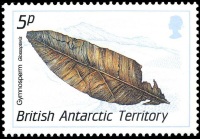
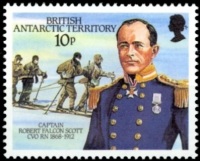 On the first expedition, he set a new southern record by marching to latitude 82°S and discovered the
Antarctic Plateau, on which the South Pole is located.
On the first expedition, he set a new southern record by marching to latitude 82°S and discovered the
Antarctic Plateau, on which the South Pole is located. On the second venture, Scott led a party of five which reached the South Pole on 17 January 1912, less than five weeks after Amundsen's South Pole expedition.
Scott and his companions died on the second expedition.
When Scott and his party's bodies were discovered, 16kg of Glossopteris tree (an extinct beech-like tree from 250 million years ago) fossils from Queen Maud Mountains were found next to their bodies, which they had dragged on hand sledges.
These fossils promised to Marie Stopes to provide an evidence for Eduard Suess's who suggested Antarctica had once been part of an ancient super-continent named Gondwanaland (now Gondwana).
The plant fossils Scott’s party found on that day in 1912 led to a breakthrough in the geological understanding of Antarctica. It would feed into the burgeoning debate at that time on Gondwanaland, Continental Drift and Antarctica’s role in the formation of the continents. At the end it proved that Antarctica had once been warm and connected to other continents as suggested by Eduard Suess, as the same fossils found in Australia, Africa and South America, it was like finding a missing piece of the Earth's jigsaw.
It indicated that these countries had all been part of the same prehistoric land mass.
[R16]
Known Philatelic items:
- commemorative stamps set "75 years since first expedition of Robert Falcon Scott to Antarctic" of the British Antarctic Territory 1987, MiNr.: 140-143, Scott: 137-140 .
- commemorative stamp in the "History of Arctic Research" set of the British Antarctic Territory 1994, MiNr.: 233, Scott: B3.
- commemorative stamp in the "Polar explorers and their ships" set of the British Antarctic Territory 2008, MiNr.: 465, Scott: ?
- commemorative stamp in the "Antarctic Explorers" set of Hungary 1987, MiNr.: 3911A, Scott: 3079
Johan Christian Senckenberg (1707 - 1772), was a German physician, naturalist and collector.
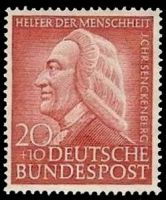
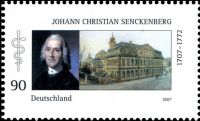 In 1763 he established the Senckenberg Foundation to support natural sciences.
In 1763 he established the Senckenberg Foundation to support natural sciences. This founded the Botanischer Garten der Johann Wolfgang Goethe-Universitat Frankfurt am Main.
His name is honoured in the Senckenberg Gesellschaft fur Naturforschung (Senckenberg Natural History Society) which he endowed and Naturmuseum Senckenberg where many dinosaurs and other fossils are present. [R17]
Nicholas Stenno (1638 - 1686), was a Danish pioneer in both anatomy and geology.
Already in 1659 he decided not to accept anything simply written in a book, instead resolving to do research himself.
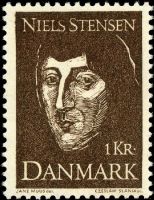
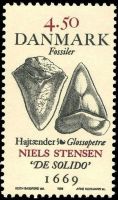 He is considered the father of geology and stratigraphy.
He is considered the father of geology and stratigraphy. October 1666 two fishermen caught a huge female shark near the town of Livorno, and Ferdinando II de' Medici, Grand Duke of Tuscany, ordered its head to be sent to Steno.
Steno dissected the head and published his findings in 1667. He noted that the shark's teeth bore a striking resemblance to certain stony objects, found embedded within rock formations, that his learned contemporaries were calling glossopetrae or "tongue stones".
Ancient authorities, such as the Roman author Pliny the Elder, in his Naturalis Historiae, had suggested that these stones fell from the sky or from the Moon.
Others were of the opinion, also following ancient authors, that fossils naturally grew in the rocks.
Steno's contemporary Athanasius Kircher, for example, attributed fossils to a "lapidifying virtue diffused through the whole body of the geocosm", considered an inherent characteristic of the earth an Aristotelian approach.
Fabio Colonna, however, had already shown in a convincing way that glossopetrae are shark teeth, in his treaty De glossopetris dissertatio published in 1616.
Steno added to Colonna's theory a discussion on the differences in composition between glossopetrae and living sharks' teeth, arguing that the chemical composition of fossils could be altered without changing their form, using the contemporary corpuscular theory of matter.
Steno's work on shark teeth led him to the question of how any solid object could come to be found inside another solid object, such as a rock or a layer of rock.
The "solid bodies within solids" that attracted Steno's interest included not only fossils, as we would define them today, but minerals, crystals, encrustations, veins, and even entire rock layers or strata.
He published his geologic studies in De solido intra solidum naturaliter contento dissertationis prodromus, or Preliminary discourse to a dissertation on a solid body naturally contained within a solid in 1669.
Steno was not the first to identify fossils as being from living organisms; his contemporaries Robert Hooke and John Ray also argued that fossils were the remains of once-living organisms. [R18]
Eduard Suess (1831-1914) was born in London on August 20, 1831.
He was full professor of geology at the University of Vienna and at the same time a full member of the Vienna Academy of Sciences.
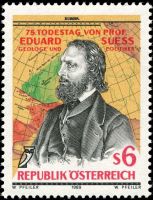 His first book "Der Boden der Stadt Wien" ("The Soil of Vienna"), which dealt with the
correlation of geologic conditions and water supply, marked the beginning of his increasing
scientific recognition from that time forward.
His first book "Der Boden der Stadt Wien" ("The Soil of Vienna"), which dealt with the
correlation of geologic conditions and water supply, marked the beginning of his increasing
scientific recognition from that time forward. He gradually developed views on the connection between Africa and Europe; eventually he came to the conclusion that the Alps to the north were once at the bottom of an ocean, of which the Mediterranean was a remnant.
While not quite correct (mostly because plate tectonics had not yet been discovered he used the earlier geosyncline theory), this is close enough to the truth that he is credited with postulating the earlier existence of the Tethys Ocean, which he named in 1893.
Suess postulated that as sediments filled the ocean basins the sea levels gradually rose, and periodically there were events of rapid ocean bottom subsidence that increased the ocean's capacity and caused the regressions. This became known as the theory of eustasy (eustacy).
His other major theory involved glossopteris fern fossils occurring in South America, Africa, and India (as well as Antarctica, though Suess did not know this).
His explanation was that the three lands were once connected in a supercontinent, which he named Gondwanaland.
Again, this is not quite correct: Suess believed that the oceans flooded the spaces currently between those lands, when in fact the lands drifted apart.
Still, it is so similar to what is currently believed that his naming has stuck. [R19]
Alfred Russel Wallace (1823-1913) was a British naturalist, explorer, geographer, anthropologist and biologist.
He is best known for independently proposing a theory of evolution due to natural selection that prompted Charles Darwin to publish his own theory.
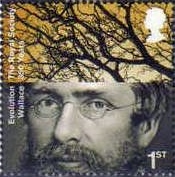
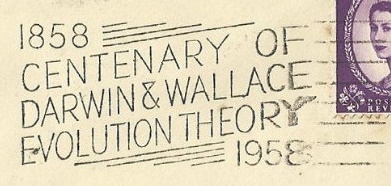 Wallace did extensive fieldwork, first in the Amazon River basin and then in the Malay Archipelago,
where he identified the Wallace Line that divides the Indonesian archipelago into two distinct parts,
one in which animals closely related to those of Australia are common, and one in which the species are
largely of Asian origin.
Wallace did extensive fieldwork, first in the Amazon River basin and then in the Malay Archipelago,
where he identified the Wallace Line that divides the Indonesian archipelago into two distinct parts,
one in which animals closely related to those of Australia are common, and one in which the species are
largely of Asian origin. He was considered the 19th century's leading expert on the geographical distribution of animal species and is sometimes called the "father of biogeography".
Wallace was one of the leading evolutionary thinkers of the 19th century and made a number of other contributions to the development of evolutionary theory besides being co-discoverer of natural selection.
These included the concept of warning colouration in animals, and the Wallace effect, a hypothesis on how natural selection could contribute to speciation by encouraging the development of barriers against hybridization.
Wallace was strongly attracted to unconventional ideas.
His advocacy of Spiritualism and his belief in a non-material origin for the higher mental faculties of humans strained his relationship with the scientific establishment, especially with other early proponents of evolution.
In addition to his scientific work, he was a social activist who was critical of what he considered to be an unjust social and economic system in 19th century Britain.
His interest in biogeography resulted in his being one of the first prominent scientists to raise concerns over the environmental impact of human activity.
Wallace was a prolific author who wrote on both scientific and social issues; his account of his adventures and observations during his explorations in Indonesia and Malaysia, The Malay Archipelago, was one of the most popular and influential journals of scientific exploration published during the 19th century. [R20]
Alfred Lothar Wegener ( 1880 -1930) was a German scientist, geophysicist, and meteorologist.
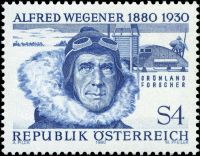 He is most notable for his theory of continental drift (Kontinentalverschiebung), proposed in 1912,
which hypothesized that the continents were slowly drifting around the Earth.
He is most notable for his theory of continental drift (Kontinentalverschiebung), proposed in 1912,
which hypothesized that the continents were slowly drifting around the Earth. However, his hypothesis was not accepted until the 1950s, when numerous discoveries such as palaeomagnetism confirmed his hypothesis of continental drift.
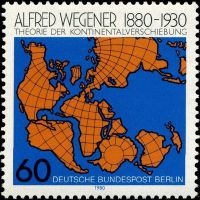 Alfred Wegener first thought of this idea by noticing that the different large landmasses of the Earth
almost fit together like a jigsaw.
Alfred Wegener first thought of this idea by noticing that the different large landmasses of the Earth
almost fit together like a jigsaw. The Continental shelf of the Americas fit closely to Africa and Europe, and Antarctica, Australia, India and Madagascar fit next to the tip of Southern Africa. But Wegener only took action after reading a paper in Autumn 1911 and seeing that a flooded land-bridge contradicts isostasy.
Wegener's main interest was meteorology, and he wanted to join the Denmark-Greenland expedition scheduled for mid 1912.
So he hurried up to present his Continental Drift hypothesis on 6 January 1912.
He analyzed either side of the Atlantic Ocean for rock type, geological structures and fossils.
He noticed that there was a significant similarity between matching sides of the continents, especially in fossil plants.
His hypothesis was thus strongly supported by the physical evidence, and was a pioneering attempt at a rational explanation. [R21]
Ole Worm (1588-1654) was originally physician in Copenhagen, but it was as a naturalist and founder of Denmark's very first museum that he inscribed his name in history.
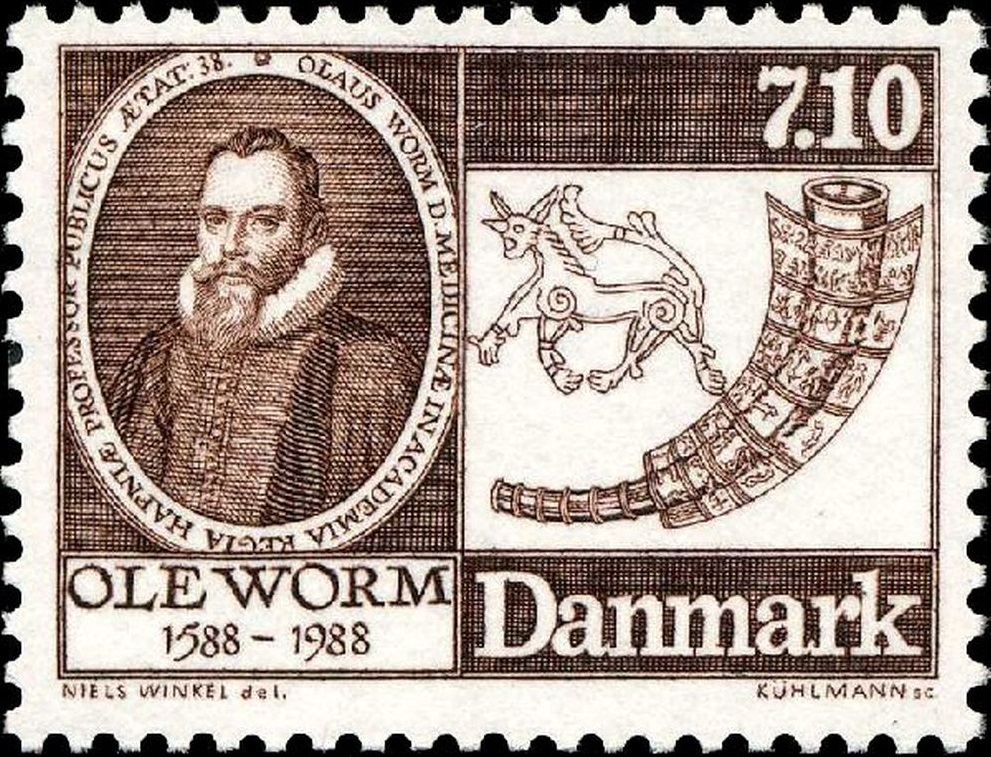
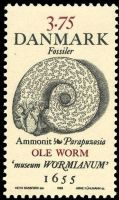 The museum was named after himself, "Museum Wormianum", and was a true cornucopia of antiquities,
ethnographic items, and stuffed animals.
The museum was named after himself, "Museum Wormianum", and was a true cornucopia of antiquities,
ethnographic items, and stuffed animals. During the Renaissance such museums were established many places in Europe and called "Nature Cabinets" and served as a kind of research libraries for anything not yet described in books.
The Danish museum no longer exists, but most of the items are now transferred to and on display in the National Museum and Zoological Museum.
One stamp (the right one) of "Drawings of fossil animals from old books - Historiske Fossile" set issued in Denmark on 1998 shows Ammonit parapuzosia, a fossil discovered by Ole Worm.
The stamp is part of a souvenir sheet containing four different stamps on historic fossils. [R22]

|
- [R1] Georgius Agricola: Wikipedia, Encyclopedia Britannica.
- [R2] Mary Anning: Wikipedia, Encyclopedia Britannica, Berkley, NHM of London.
- [R3] Grigores Antipa: Wikipedia,
- [R4] Georges-Louis Leclerc, Comte de Buffon : Wikipedia,
- [R5] Zdenek Burian: Wikipedia,
- [R6] Charles Darwin: Wikipedia, Encyclopedia Britannica, Darwin ONline - the world's largest and most widely used resource on Charles Darwin.
- [R7] Saturnin Garimond: amisdesaturningarimond.fr, palaeovertebrata.com.
- [R8] Thomas Henrey Huxley: Wikipedia,
- [R9] Thomas Jefferson: Early America,
- [R10] Jean Baptiste Lamarck: Wikipedia,
- [R11] Carl Linne: Wikipedia,
- [R12] Charles Wilson Peale: Wikipedia,
- [R13] Bernard Paliss : Wikipedia,
- [R14] Emil Racovita: Wikipedia,
- [R15] Antonio Raimondi: Wikipedia, limaeasy.
- [R16] Robert Falcon Scott: Wikipedia, BBC, Expeditions fieldmuseum.
- [R17] Johan Christian Senckenberg: Wikipedia,
- [R18] Nicholas Stenno/Neils Stensen: Wikipedia.
- [R19] Eduard Suess: Wikipedia, Gondwana (Wikipedia),
- [R20] Alfred Russel Wallace: Wikipedia, The Alfred Russel Wallace Website, "The fossil tree" by George Beccaloni, "A. R. Wallace to be featured on a British stamp!", Alfred Russel Wallace on Postage Stamps.
- [R21] Alfred Lothar Wegener: Wikipedia,
- [R22] Ole Worm: Wikipedia, Museum Wormianum.
- [R23] Juan Bautista Ambrosetti: Wikipedia, ecured.cu.
- [R24] Francisco Pascasio Moreno: Wikipedia encyclopedia.com
- [R25] Francisco Javier Muñiz Wikipedia
- [R26] Ignacy Domeyko Wikipedia, Lituanica on stamps, PhilaIndia,
- [R27] Shen Kuo Wikipedia
- [R28] Karl Ernst von Baer:
Wikipedia,
Adam's mammoth,
Carl Friedrich Schmidt,
" Siberian Woolly Mammoths and Studies into Permafrost in the Russian Empire in the 19th Century" by Erki Tammiksaar and Ken Kalling from Centre for Science Studies, Estonian University of Life Sciences
" Alexander von Middendorff and his expedition to Siberia (1842–1845)" by Erki Tammiksaar from Centre for Science Studies, Estonian University of Life Sciences and Ian R. Stone Scott Polar Research Institute, University of Cambridge. - [R29] Carl Anton Larsen: Wikipedia, archiveshub, antarctic-logistics, antarcticreport. captainantarctica.